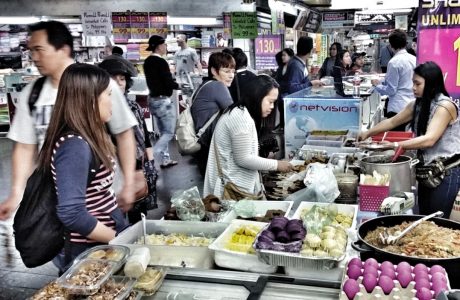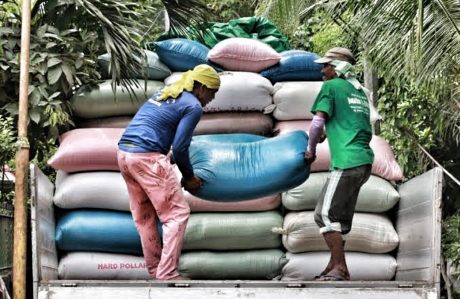So-called “investigative” journalist Raissa Robles had a laugh at my Twitter post the other day about Philippine inflation. She wasn’t specific about why she thought I didn’t know what I was talking about though and I never got the chance to ask since she blocked me. What’s up with people like that? They block others they don’t agree with, but they take the trouble to go to the profile of the person they blocked just to read the posts. They seem to be showing signs of insecurity and feel the need to monitor if others are talking about them. But I digress…
Anyway, so I made a comment saying that from what I understand, inflation is when an economy grows and there is increased spending that consequently exerts upward pressure on prices. Therefore, one way to control inflation is to curb the spending power of consumers by increasing interest rates. The public can help by putting a hold on spending and save money instead.

Of course there are other causes of inflation, I was merely citing one. But the main problem people like Robles have with my statement is they think I was trying to absolve President Rodrigo Duterte from the rising prices of goods in the country. They think anyone who tries to analyse an issue using neutrality is simply trying to make excuses for the people they are against, which, in this case, is the Duterte government. They also assume that anyone who criticises the Aquinos and the Liberal Party are Marcos loyalists. They suffer from an acute tunnel vision syndrome and think every policy or initiative by anyone not allied with the Aquinos is geared towards Marcosian doctrine. It is worth pointing out that these people are a big part of why the Philippines cannot progress. They are stuck in the past. But I digress once again…
Anyway, understanding inflation starts with the basic law of supply and demand. A lot of factors affect the prices of goods and if we look at the prices of rice and other food products for example, it’s easy to conclude that the prices have skyrocketed because demand for them is high and supply is low. Filipinos love their rice so much but, unfortunately, have had to import rice due to their inability to produce enough rice for their own consumption. There are also reports that rice importers and traders have been hoarding and holding on to the supply to create a “crisis” so they can manipulate the prices to their favour.
It is the role of the Central Bank of the Philippines to maintain price stability and to balance and sustain economic growth. The Central Bank can set interest rates to reduce demand and lower inflation. They can also control the money supply. When there is too much money floating around, the value of the currency can go down. Just to give an example, the Spanish economy collapsed when gold and silver flowed into the Spanish and other European economies after the Spanish conquest of the Aztec and Inca empires. Since the money supply had increased, prices spiked and the value of money fell.
Increasing competitiveness and efficiency of the economy can also put downward pressure on prices as efficiency gains allow progressively larger amount of goods to be produced, moved, and traded for less cost per unit. The good news is, the latest Global Competitiveness Report 2018, showed the Philippines rising 12 rungs from last year to 56th of a total of 140 countries and regions citing improvement in infrastructure particularly the country’s airport and shipping connectivity:
Economic growth in the Philippines exceeded 6%, along with China, Cambodia and two other countries in Southeast Asia. The WEF also noted that the country’s safety improved over the year, with scores in indicators including organized crime, homicide rate and incidence of corruption rising. It ranked 21st in social capital.The country’s infrastructure such as airport and shipping connectivity improved as well. On the other hand, the Philippines still needs to enhance education, its product market as well as its workforce, the report shows.

Speaking of Philippine infrastructure, the country consists of group of islands and you don’t have to be a genius to realize that transporting goods contribute significant costs that eventually get passed to consumers. So if a clove of garlic has to be transported from Nueva Ecija, the infrastructure involved in transporting it and the fuel costs have to be taken into consideration. It doesn’t help that global oil prices have gone up. This is something the Central Bank cannot control. But, of course, the members of the Opposition ignore this part of the equation and blame even the rise in fuel cost on the Duterte government.
Duterte’s economic managers have decided to suspend the fuel excise tax until next year in response to the inflation rate hitting 6.4 percent. Calls by the Opposition to suspend the new Tax Reform for Acceleration and Inclusion (TRAIN) law fell on deaf ears. As former President and now Speaker of the House of Representatives Gloria Arroyo said, the new tax law only played a small portion in the country’s rising inflation:
Arroyo explained that the five main drivers which have direct effects on inflation are the peso-dollar exchange rate; and the market prices of rice, fish, meat, and oil.Arroyo said that the Duterte administration’s economic managers should focus on ensuring that there is enough supply of rice, fish, and meat so that market prices will remain stable.
The country’s infrastructure is something that needs to be prioritized if the government is serious about sustainable growth and keeping inflation at bay. It’s bad enough that the country’s production of crops gets battered by typhoons and the country’s roads and transport system are still stuck in the Martial Law years. Train lines connecting the provinces should be built to provide alternatives to the use of trucks that compete for space in the country’s limited roads and highways. Trains could also cut travel times and there wouldn’t be wastage due to goods going bad while in transit.
Unfortunately, the previous government did not think long-term and did not do enough to upgrade the country’s infrastructure. They were more preoccupied with campaigning for the next election, which they lost. Former President Benigno Simeon Aquino III even has the audacity to say that the people probably miss him now with the country’s inflation rate. If he was really that good, then the problems Duterte is facing now would not even exist. If he was that good, Aquino would have initiated policies that could have prevented the rice crisis from happening again for instance. He would have fixed the transport system including the trains and eliminated the horrendous traffic that contributes to the loss in business revenue every year and attracted more investments from overseas that would create more jobs for Filipinos.
Yes, Aquino and supporters should quit deluding themselves into thinking the people miss their “greatness”. Some of them can’t even understand what the real cause of inflation is. If they did, they wouldn’t be laughing because they would realize they were part of the cause.

No comments:
Post a Comment